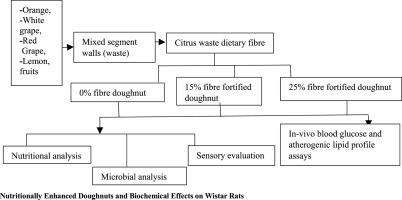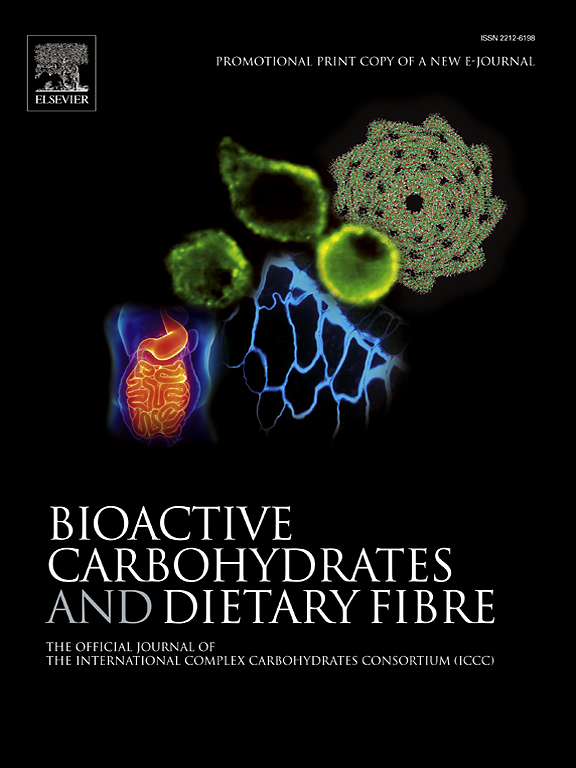Nutritional enhancement and biochemical effects of citrus waste dietary fibre in wistar albino rats fed fortified doughnuts
IF 3.6
引用次数: 0
Abstract
Dietary fibre extracted manually from citrus wastes of orange, white grapefruit, red grapefruit, and lemon was used to fortify doughnuts as a potential solution to non-communicable diseases. Sixteen Wistar albino rats equally divided into four groups were fed the fibre-fortified doughnuts ad libitum for 28 days at 25, 15, and 0 % fibre inclusion; and another control group fed standard rat pellets. Nutritional, microbiological, and sensory properties were examined on doughnuts while the rats' weight and biochemical indices were assessed after feeding. Obtained data was statistically analysed using ANOVA and post-hoc tests. Proximate analysis of the doughnuts revealed moisture range (4.06–10.21 %), ash (1.87–2.09 %), fibre (0.01–0.26 %), fat (6.67–35.84 %), protein (10.17–16.37 %), and carbohydrate (46.81–64.68 %) with the significantly (p < 0.05) highest crude fibre (0.26 %) in 25 % sample, showing improvement over regular doughnuts for gut health. Microbiological analysis showed safe TVB counts (7.0 × 103–8.0 × 104 CFU/g) and the absence of pathogens, supported by low moisture. Sensory assessment rated the fibre-fortified doughnuts in the range of 6–7 on a 9-point hedonic scale, indicating high acceptability. Average rats’ blood glucose ranged 61–79 mg/dL; 18.37–114.80 mg/dL in atherogenic lipid profiles (TC, TG, VLDL-C, and LDL-C) were lowest in 25 % fibre group and highest in HDL-C of the range (7.16–19.00 mg/dL), showing the most efficient in lowering blood glucose and atherogenic lipid profiles in the experimental rats compared to the control groups and better performance than the 15 % fibre doughnut. Thus, 25 % citrus fruit-waste-fibre-fortified doughnuts could be a nutritionally enhanced fast-food option to lower the risks of cardiovascular disease and diabetes.

柑橘废膳食纤维对强化甜甜圈对wistar白化大鼠的营养增强及生化影响
人工从橙子、白葡萄柚、红葡萄柚和柠檬等柑橘类废弃物中提取膳食纤维,用于强化甜甜圈,作为非传染性疾病的潜在解决方案。16只Wistar白化大鼠平均分为4组,在纤维含量为25%、15%和0%的情况下,随意饲喂纤维强化甜甜圈28天;另一组喂食标准大鼠颗粒。研究了甜甜圈的营养、微生物和感官特性,并对大鼠喂食后的体重和生化指标进行了评估。所得资料采用方差分析和事后检验进行统计学分析。对甜甜圈进行近似分析,发现水分范围为4.06 - 10.21%,灰分范围为1.87 - 2.09%,纤维范围为0.01 - 0.26%,脂肪范围为6.67 - 35.84%,蛋白质范围为10.17 - 16.37%,碳水化合物范围为46.81 - 64.68%,其中25%样品中的粗纤维含量最高(p < 0.05),比普通甜甜圈对肠道健康有改善。微生物学分析显示TVB计数安全(7.0 × 103-8.0 × 104 CFU/g),低湿度条件下无病原菌。感官评估对纤维强化甜甜圈的评分为6-7分,满分为9分,表明可接受性很高。大鼠平均血糖为61 ~ 79 mg/dL;在18.37 ~ 114.80 mg/dL的致动脉粥样硬化脂质(TC、TG、VLDL-C和LDL-C)范围内,25%纤维组最低,HDL-C最高(7.16 ~ 19.00 mg/dL),与对照组相比,在降低实验大鼠血糖和致动脉粥样硬化脂质方面效果最好,性能优于15%纤维甜甜圈组。因此,25%柑橘类水果废料纤维强化的甜甜圈可能是一种营养增强的快餐选择,可以降低患心血管疾病和糖尿病的风险。
本文章由计算机程序翻译,如有差异,请以英文原文为准。
求助全文
约1分钟内获得全文
求助全文
来源期刊

Bioactive Carbohydrates and Dietary Fibre
Agricultural and Biological Sciences-Food Science
CiteScore
6.00
自引率
0.00%
发文量
38
期刊介绍:
 求助内容:
求助内容: 应助结果提醒方式:
应助结果提醒方式:


